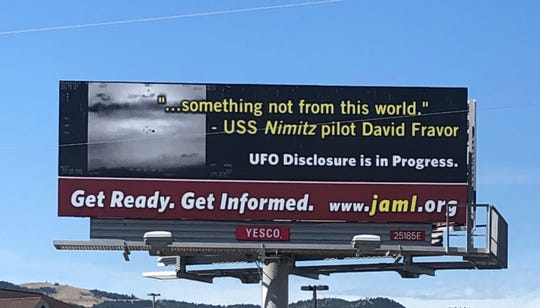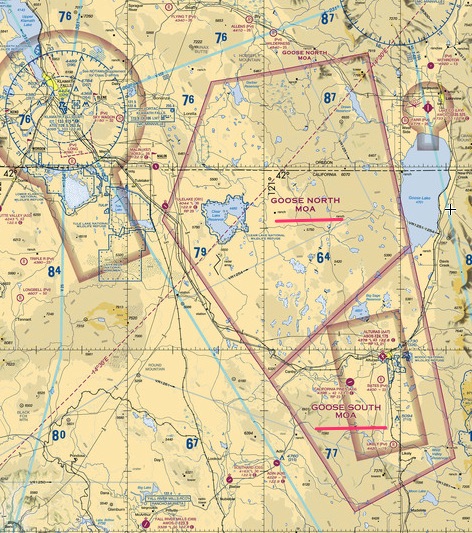 |
| A photo of a sign along Highway 12 near Helena, Montana published in the Great Falls Tribune, Sept. 14. "JAML" is the Jesse A. Marcel library, attempting to promote "UFO Disclosure". |
What has been happening in the world of TTSA lately, besides starting their second round seeking funding? Researcher John Greenewald of The Black Vault has been publishing some excellent analyses of TTSA-related claims and information (and taking a lot of flak from those who don't like what he has found). He has confirmed once again that TTSA's famous three videos were not "released" by the Pentagon (as TTSA endlessly claims), but apparently leaked:
“The videos were never officially released to the general public by the DoD and should still be withheld,” said Pentagon Spokesperson Susan Gough to The Black Vault earlier this year. Mr. Gradisher, on behalf of the Navy, confirms the Pentagon’s position this week by adding, “The Navy has not released the videos to the general public.”
On September 11, Greenewald published the latest information he has received from the Pentagon.
We finally have the dates for the three IR videos promoted by TTSA.
“[The] dates are 14 November 2004 for ‘FLIR1’ and 21 January 2015 for
both ‘Gimbal’ and ‘GoFast.’” This tends to confirm what I wrote earlier
that "it
appears that the Gimbal video, and the Go Fast video, were taken by the
same aircraft, by the same pilot, on the same mission, and less than 20
minutes apart." So TTSA doesn't really have three different Navy UFO videos, just two. Or so it seems.
 |
| Tom DeLonge says that TTSA plans to build spaceships |
Explaining
the use of the term "UAP," Joseph Gradisher, a spokesperson for the
Deputy Chief of Naval Operations for Information Warfare, told
Greenewald:
“the ‘Unidentified Aerial Phenomena’ terminology is used because it provides the basic descriptor for the sightings/observations of unauthorized/unidentified aircraft/objects that have been observed entering/operating in the airspace of various military-controlled training ranges.”From this statement, it sounds as if the Navy is only concerned about objects entering military-controlled air spaces. Aviation maps clearly mark off certain "Military Operations Areas" that are prohibited or restricted to civilian aircraft at certain times, elevations, etc to support military operations . According to the FAA, "MOAs are designated to contain nonhazardous, military flight activities including, but not limited to, air combat maneuvers, air intercepts, low altitude tactics, etc." If an unknown object enters one of those areas, the Navy investigates it as a UAP. If the object is elsewhere, they apparently don't care.
 |
| An example of a Military Operations area in Oregon |
This
same point was made by the Navy soon afterward in a different letter to
the Swedish researcher Roger Glassel. Published in the Swedish magazine
UFO-aktuellet and reproduced in part in the Facebook group UFO Updates, the Navy spokesman replied to a question about why the Navy recently changed their reporting guidelines for such incidents,
We have updated guidelines and simplified the process to facilitate reporting of unidentified aerial phenomena in order to support an objective, data-driven analysis of the range incursions.
"Range
incursions". Later in that same letter, the Navy spokesman again talks
again about "range incursions", in response to a question about the
terminology "UAS" and "UAP",
The wide proliferation and availability of inexpensive unmanned aerial systems (UAS) isn’t contradictory, it’s just when the UAS is *NOT* immediately identifiable we refer to it as UAP. A quadcopter is immediately identifiable. As we have previously acknowledged, the number of incursions into our ranges has increased with that wide proliferation and availability of inexpensive UAS. Additionally, we use the generic UAP term in communications so as not to pre-judge the results of any investigation.
Any range incursion by unauthorized craft affects the safety of our aviators and/or the security of our operations. Our revised reporting guidance solicits reports of any unauthorized craft (UAP or UAS) observed within our ranges so that we may investigate that range incursion. Incursions/sightings since 2014 may be referred to as either UAS or UAP, depending on the circumstances surrounding the specific incident in question.
When I noted this on Facebook, Glassel added the following comment:
Yes, in a hearing in the Senate on March 8, 2017, General John Hyten stated the following. "Of recent concern have been the unauthorized flights of unmanned aerial systems (UAS) over Navy and Air Force installations. These intrusions represent a growing threat to the safety and security of nuclear weapons and personnel. Both the Navy and Air Force are working to field counter-UAS capabilities that can effectively detect, track, and, if necessary, engage small UAS vehicles."
This clearly seems to confirm my above comments about John Greenewald's latest info from the Pentagon. The Navy seems only concerned with what appear to be trespassers in their private military areas. Otherwise, they would have no need for AATIP.



